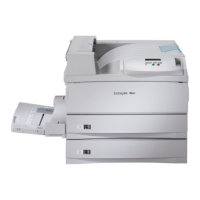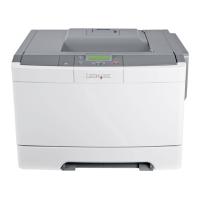PCL
2-41
Table 2-22: Alphanumeric ID
Command / Parameters Function / Result
ESC
&n#W [operation] [string]
# = number of data bytes that make up the
operation and string
Operation
operation = 100 or 1 byte = 0x64 or 'd' ascii
For example:
100 Media Select
String
string = See Alphanumeric String list at
right
Alphanumeric ID
Selects the media type using a character string. The string ID is case
sensitive and may be up to 511 bytes long.
The string ID specifies the media type requested.
MediaType AlphanumericString
Plain Paper Plain
Bond Bond
Transparency Transparency
Card Stock Card Stock
Labels Labels
Letterhead Letterhead
Pre-printed Preprinted
Colored Paper Color
Envelope Envelope
Custom Type 1 Custom Type 1 or User Type 1
Custom Type 2 Custom Type 2 or User Type 2
Custom Type 3 Custom Type 3 or User Type 3
Custom Type 4 Custom Type 4 or User Type 4
Custom Type 5 Custom Type 5 or User Type 5
Custom Type 6 Custom Type 6 or User Type 6
For example, the following shows the command and parameters used
to select bond paper:
ESC
&n5WdBond
To select letterhead paper:
ESC
&n11WdLetterhead
Table 2-23: Cursor Positioning
Command / Parameters Function / Result
ESC
&a#C
# = number of Columns
1
Horizontal Cursor Positioning (in Columns)
Moves the cursor to a new position along the horizontal axis.
Note: The column width is determined by the space character width of
the active font or the Horizontal Motion Index (HMI), if set.
ESC
&a#H
# = number of Decipoints
1
(1 Decipoint = 1/720 inch)
Horizontal Cursor Positioning (in Decipoints)
Moves the cursor to a new position along the horizontal axis.
ESC
*p#X
# = number of PCL Units
1
Horizontal Cursor Positioning (in PCL Units)
Moves the cursor to a new position along the horizontal axis.
Note: PCL units are set by the Unit-of-Measure Command.
1
Parameter preceded by + or – sign denotes a relative cursor move from the current cursor position. Parameter without a
sign denotes an absolute cursor move from the top left margin.

